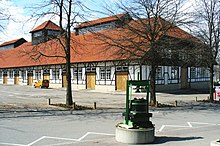Fellbacher wine grower
The fur Weingärtner eG was founded in 1858 and is the second oldest wine cooperative in the wine-growing region Württemberg . Its 274 members cultivate 170 hectares of vineyards in the Fellbach wine-growing community .
history
Viticulture in Fellbach was first mentioned in a document in 1245. Initially, the vines were grown on flat terrain, in so-called vineyards. The term Weingärtner for the winegrowers in Württemberg is derived from this. The slopes were developed later so that the flat terrain could be used for agriculture.
Due to poor harvests, the winegrowers could hardly survive in the middle of the 19th century. At that time there were around 500 winegrowers in Fellbach who ran viticulture and agriculture in small-scale businesses. An average of 0.52 hectares of vineyards and 1.52 hectares of arable land were used per farm. An average yield of 22 hl was achieved per hectare. Each winegrower pressed his vines for himself, no distinction was made between white and red grapes. The Schiller wine produced in this way was usually sold directly “under the wine press”, as the winegrowers did not have barrels to store them.
Inspired by the “Society for Wine Improvement” in Stuttgart and the Neckarsulm-Gundelsheim winegrowing cooperative , Wilhelm Amandus Auberlen founded the Fellbach wine- growing company in 1858. The common goal of the 50 members was to increase quality. For this purpose, the vines were classified in red and white as well as according to mountain wine, medium and low-growth. The wines of the Weingärtnergesellschaft could be sold 20% more expensive than the market average.
On September 5, 1938, the Weingärtnergesellschaft was merged into the newly founded Fellbach Weingärtnergenossenschaft. All 314 winegrowers in Fellbach were brought together in the Weingärtnergenossenschaft. The cooperative built a wine press with a cellar, completed in 1940, in order to develop the wine independently and sell it in bottles. She introduced the grape harvest in Fellbach.
In 2001 the Fellbach Weingärtnergenossenschaft was renamed Fellbacher Weingärtner for marketing reasons.
Growing area
The vineyards' cultivation areas are in the Kappelberg area between 310 and 430 meters above sea level. From a geological point of view, there is mainly Keuper , which is loosened with increasing height by reed sandstone , marl and sandstone . In the last 20 years an average temperature of 10.5 degrees Celsius has been reached. The average rainfall is 700 l / m².
The Kappelberg area is divided into the Lämmler and Goldberg sites. The Lämmler is counted among the top vineyards in Germany. The location is on a protected south-facing slope at the foot of the Kappelberg and has a gradient of 35%. The name probably goes back to the former owners, the Lämmle family. The location is warmed by air currents during the day and cooled at night. This leads to an intense fruit aroma.
In 2003 the red wine varieties were grown: Trollinger 81 hectares, Schwarzriesling 14 hectares, Pinot Noir 6 hectares (including Klon Mariafeld 4 hectares), Dornfelder 5 hectares, Lemberger 5 hectares, Portugieser 2 hectares. Among the white wine varieties, Riesling was 31 hectares, Müller -Thurgau on 12 ha and Kerner on 7 ha.
swell
- Otto Borst : Fellbach: a Swabian city history . Theiss , Stuttgart 1990, ISBN 3-8062-0594-9
- Otto Linsenmaier : "Chronicle of the Fellbacher Weingärtner", Fellbach 2007
- Report in the Fellbacher Zeitung


